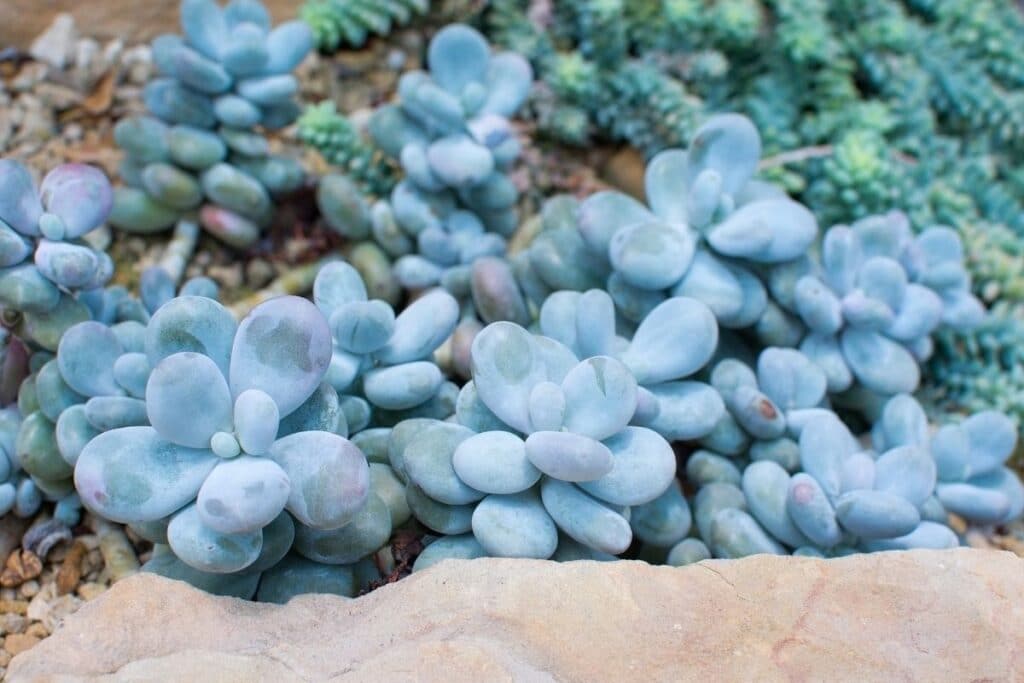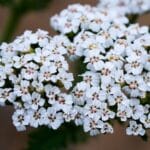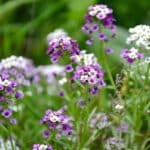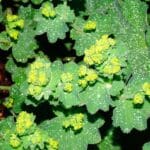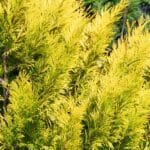Succulents come in a plethora of leaf patterns and arrangements we don’t often see in our common broad-leaved house plants. This is what makes them appealing and many growers even collect out of this world-looking succulents.
One of the best types to start with is the moonstone plant, a tough succulent that will captivate you, not just with its fleshy leaves but with its sensational bloom as well.
What is a Moonstone Succulent?
No, we are not talking about a gemstone but a plant that may look just as precious. Pachyphytum oviferum, also called sugar almond plant or moonstone plant, is a succulent from the Crassulaceae family, just like the jade plant.
It originated from Mexico and is described as having a thick plant of powdery egg-like plump bluish green leaves (1).
The succulent plant is low-growing with a height of 10cm and spread of 30cm. The stem is upright at first but as it grows, the weight of the chubby leaves will recline the plant on the ground (2). Over time, it will produce offsets that grow close together creating an attractive congestion of leaves that may look like a mound of pebbles.
What does the Moonstone Flower Look Like?
Sometime in late winter or early spring, the moonstone plant will produce graceful flowers. A long floral stalk will emerge in the middle of the plant bearing a series of fleshy grey-green sepals and several downward-facing red flowers with a yellow center (3).
Can you grow Moonstones Outdoors?
Moonstone plants, originally found in the rocky cliffs of Mexico, can definitely be grown outdoors. Although they will thrive just fine on the ground under full sun, these plants cannot tolerate temperatures below 7°C outdoors and will decline with frost. However, they are hardy and can overwinter indoors. When caring for moonstones, keep the soil moist but not overly wet.
Are Moonstones Toxic to Pets?
The moonstone plant is not considered as toxic to pets and humans. If ingested in large amounts, it may upset the stomach but there is no serious effect. The plant has quite a delicate form so better to keep them out of reach of toddlers and pets.
What are the Best Moonstone Varieties to Grow?
While P. oviferum is already sensational in its natural original form, breeders and cultivators still strive to produce new and more remarkable varieties. P. oviferum f. variegatum has a soft bluish-green to bluish-purple tinge with yellow variegation.
There are pink, purple, green and bronze varieties too. The most popular type is probably a pink moonstone succulent. Under the genus Pachyphytum, some species that resemble moonstones are P. bracteosum and P. ‘Garnet Fudge’ (1).
How to Care for Your Moonstone Plant
Light and Water
The moonstone plant likes sunshine, so make sure it receives at least 6 hours of exposure to direct sunlight outdoors. You can use a grow light if you grow indoors.
Potted ones should be placed in a sunny window where there is bright light, particularly during the dimmer days of winter (3).
The golden rule to growing succulents is to never give them too much water. It’s important not to get the leaves wet when you water because they can rot. Root rot can occur if the soil remains excessively wet for prolonged periods.
Water the plant from below by submerging the half the height of the pot in water for 1-2 minutes. Ensure that the pot has adequate drainage holes to facilitate proper water flow (3).
Soil
Remember, using the right soil is crucial for Pachyphytum oviferum’s success. Pachyphytum oviferum thrives in well-draining soil. Use a specialized cactus or succulent potting mix, or create your own by mixing regular potting medium with perlite or coarse sand in a 1:1 ratio. This mixture ensures proper drainage, preventing root rot.
Temperature and Humidity
Pachyphytums are generally tough and are considered hardy in US zones 10a to 11b. But there are limits to the temperatures they can be exposed to. They can survive 10-27°C plant indoors, while prolonged exposure to 7°C and below will eventually kill the plant. The plant can tolerate a high temperature but it needs humidity and good airflow to keep the foliage plump and fleshy.
Pests and Diseases
The moonstone plant does not have serious pests and diseases but they can fall prey to aphids and mealybugs that like to suck and chew on healthy fleshy leaves. Common signs and symptoms of these pests are their presence on the leaves, stems, and soil and the shriveling of the leaves.
Control these pests by spraying with insecticidal soap or manually removing them if there are only a few signs. When it comes to rotting of any part of the plant, it is often caused by too much moisture. Always monitor the amount of water the plant is receiving. When in doubt, give the plant 1-2 more days to completely dry before watering again.
Propagation and Maintenance
The most common and successful way of propagating succulents, including moonstone succulents is through leaf cuttings. Simply twist some of the lower leaves and make sure that they do not tear. Lay them on top of a standard succulent or cacti potting mix in a tray and mist sparingly. Placed in a well-lit and well-ventilated location, new leaves and roots will appear in a span of 3-4 weeks.
Sometimes, when moonstones are positioned in a poorly-lit area, the leaves may prematurely drop and the plant will grow leggy. When this happens, cut the tall stems of the plant near the base and propagate the leaves.
Place the plant in a better location, allow the stem to callus, and withdraw from watering. After several weeks, a new shoot growth should be observed.
These drought tolerant plants do not require a lot of attention as long as their light and water requirements are met. Over the years they will develop more roots which may cause the plant to wilt fast and have yellow leaves. It is recommended to repot these succulent plants after flowering to allow the roots to breathe and to replenish the nutrients in the soil (3).
Moonstone plants are normally seen potted individually or in a cluster. Although its beauty can stand on its own, moonstones can be combined with other succulents too and they will surely brighten up any sunny or partly shaded areas of the garden or even a dish garden.
FAQs
Is Pachyphytum an indoor plant?
Yes, Pachyphytum species, including the Moonstone plant (Pachyphytum oviferum), are commonly grown as indoor plants. They thrive in bright, indirect sunlight and moderate temperatures, making them suitable for indoor environments.
How often do you water a Moonstone plant?
The watering frequency for a Moonstone plant depends on factors like temperature, humidity, and potting mix. Generally, water it when the top inch of soil feels dry, typically every 7-10 days. Adjust watering frequency based on environmental conditions to prevent overwatering or underwatering.
What happens if moonstone gets wet?
If a Moonstone plant gets wet, especially if water sits on its leaves for an extended period, it can lead to problems such as rot or fungal diseases. It’s essential to avoid wetting the foliage excessively and ensure proper drainage to prevent waterlogging.
Does the sun damage moonstone?
While Moonstone plants enjoy bright, indirect sunlight, prolonged exposure to intense sunlight can cause their leaves to become sunburned or scorched. It’s best to provide them with filtered sunlight or partial shade, especially during the hottest part of the day, to prevent leaf damage.
Final thoughts
In summary, Pachyphytum oviferum thrives in bright light and well-draining soil. To care for these delightful succulents, avoid overwatering, provide enough light, and ensure proper drainage holes in their pots. With proper care of these details, you’ll enjoy their unique beauty and resilience.
References
Reference List
(1) McGowan, A. & McGowan, B. Bulbs in the Basement, Geraniums on the Windowsill: How to Grow and Overwinter 165 Tender Plants. Storey Publishing. 2012. P. 208.
(2) Crassulaceae Network. Pachyphytum. International Crassulaceae Network.
(3) Maguire, K. The Kew Gardener’s Guide to Growing House Plants: The Art and Science to Grow Your Own House Plants. White Lion 2. 2019. P. 144.
Close
Photo by depositphotos.com/ArtesiaWells

